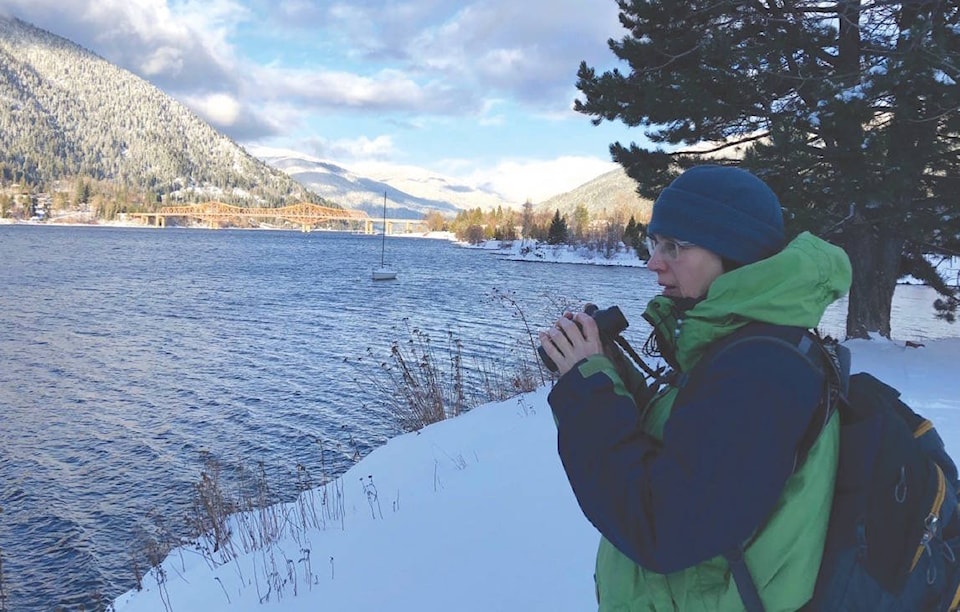The birders gathered at a coffee shop in Nelson on Dec. 31 all seemed so cheerful and contented. They had just come in from spending the day in the Christmas bird count.
”It was a lovely day, sunny, not windy,” said Daphne Van Alstine. “The highlight was a Red-breasted Nuthatch, which was right at the top of the tree sitting in the sun, and sat there for a while. They never usually sit, they are always flitting around.”
Brian and July D’Eon have been doing Nelson’s bird count for its full 20 years.
“The highlight was seeing some Pine Grosbeaks,” Brian said. “They are spectacular birds, in a mountain ash, having lots of fun munching the berries. Also Redpolls. Some years you never see them.”
“And a Pileated Woodpecker,” Judy added.
“It is restorative to your soul,” Brian said, “to see the little creatures and see how they are doing, and you realize you are all part of the same system. Just that feeling of renewal, that we are all in this together.”
About 30 people went out on this year’s Nelson bird count, each person or small group assigned to a specific part of town. They recorded every bird they saw. The numbers are fed into an international database at the Audubon Society, which has been sponsoring bird counts across the continent for 118 years.
The Nelson crew saw 2,094 birds this year. The 12-year Nelson average is 2,300.
They recorded 52 species including 80 Common Redpolls, 10 wild turkeys (their numbers are on an upswing in the area), two Red-tailed Hawks, 46 Song Sparrows, and 11 Red-breasted Nuthatches.
“I had a fabulous day,” said Len Dunsford. “I saw 15 goldfinches on my feeder, and have not seen them for a while. An eagle almost landed on our roof. Birding is wonderful, I enjoy every minute of it. I’ve been doing this for years and years and years.”
Jeremiah Kennedy has organized the B.C. Lower Mainland bird counts for several years. The Masters student biologist (he studies owl behaviour and interaction) now a resident in Edmonton says for conservationists there is not a lot of good news these days.
“Whenever I do the Christmas bird count I get excited again. It is one of those good news stories you can hold onto in the dark winter time.”
He says the count has an important data collection function even though it is a limited snapshot because it happens on only one day.
“That is a weakness, and also a strength over a larger period of time. The only way you can use the Christmas bird count data is over a very long period. Because we have over 100 counts that get done in B.C., that is a snapshot but it is a snapshot across the entire province.”
He said the bird count has alerted scientists to some important trends, like the decline in Western Screech Owl populations that started in the 1970s.
Another example is the recovery of raptors after the elimination of the pesticide DDT. That data was first noticed in the bird counts.
Data from all bird counts on the continent, including Nelson’s, can be found on the Audubon Society website at audubon.org.
But it’s about more than data, Kennedy said, and that brings us back to the cheerful camaraderie in the mall after the Nelson bird count.
“It is about engagement and education and outreach. People take so much pride in doing the bird count every year.”
He said that pride is contagious, and the bird counts are growing.
“Across B.C. we get thousands of people that take part.”
Kennedy said you don’t need to know a lot about birds to take part in a bird count. When he organizes bird counts he pairs experienced birders with newcomers.
Local birder Paul Prappas said the bird counts were part of the beginnings of what’s known as citizen science.
“In the old days the bulk of information about wildlife was from scientists. The whole citizen science movement is to collect as much data as possible,” he said.
He said bird data can be used to push for environmental reform.
“We want to get people more interested in birds so that when an area is going to be developed or destroyed, like our waterfront development, if there are enough people saying, look, we have birds coming through there and we don’t have enough natural area for wildlife, they will start to care.”
“The more people who connect over seeing birds, the more people will say, you know what, I like birds. They are cool, colourful, vastly, vastly varied, and then when an issue comes up around destroying an area they might care.”
The Christmas bird count originated around the beginning of the 2oth century along with the beginnings of the conservation movement. It evolved from the Christmas “side hunt” in which men would choose sides and compete to see who could kill the largest number of birds.
Beginning on Christmas Day, 1900, the ornithologist Frank M. Chapman began a Christmas bird census in which people would observe and count birds rather than kill them.
